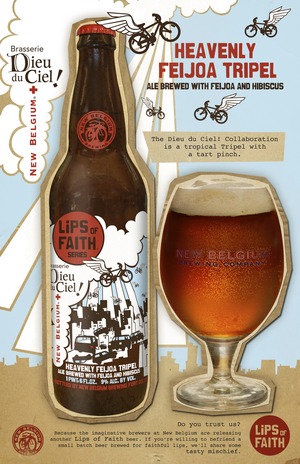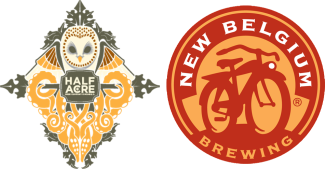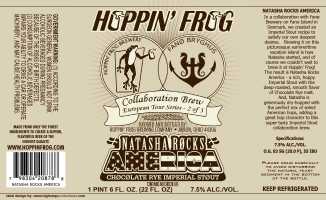 TRADITIONAL BELGIAN tripels are remarkable for many reasons, not least among them the complexity they extract from a modicum of ingredients. Heavenly Feijoa, a recent Lips of Faith collaboration between New Belgium Brewing and Dieu du Ciel!, is the antithesis of such economy. With hibiscus, feijoa juice, pungent New Zealand hops, and even a small dose of black malt, this 9.4% ABV tripel risked being a garish waste of ‘artisanal’ ingredients. Yet all these strange tweaks share a common thread, revealing the conscientious craftsmanship that drives this series—a refreshing reminder after a string of seemingly haphazard disappointments—and the results are rather charming.
TRADITIONAL BELGIAN tripels are remarkable for many reasons, not least among them the complexity they extract from a modicum of ingredients. Heavenly Feijoa, a recent Lips of Faith collaboration between New Belgium Brewing and Dieu du Ciel!, is the antithesis of such economy. With hibiscus, feijoa juice, pungent New Zealand hops, and even a small dose of black malt, this 9.4% ABV tripel risked being a garish waste of ‘artisanal’ ingredients. Yet all these strange tweaks share a common thread, revealing the conscientious craftsmanship that drives this series—a refreshing reminder after a string of seemingly haphazard disappointments—and the results are rather charming.
The beer’s looks are traditional, if a little underwhelming: golden, a little hazy, and with a thin layer of white head but no lasting bubbles. The aroma blends ginger snap and lemon with an unexpected twist of tart berry coming from the feijoa juice, presumably bolstered by almost winey Nelson Sauvin hops. That bouquet presages a surprisingly tart, forward-focused flavor that shifts its focus from citrus early to berries late. Yeast and malt are more apparent in between, though more for the other flavors’ waning than their own waxing. Marked as Best Before March 2014, the beer’s has clearly smoothed considerably since its bottling—at that time a spicier midsection and more assertive effervescence would likely have helped keep its distinctive corners pinned up neatly. Carbonation remains fairly high, though, with small and creamy bubbles carrying smoothly from front to back and leaving the finish fairly clean, if not especially lasting. The beer’s body is likely a little fuller than most tripels, too, and the juice likely didn’t ferment out quite as cleanly as the traditional adjunct of candi sugar. Perhaps that aging has also diminished the alcohol presence, since a 9.4% ABV is rarely so unobtrusive, especially in a tripel. The ultimate balance is well-struck between mild titillation and simply good refreshment.
Served: 750 ml bottle best before March 2014
Rating: 85








 THOUGH THE HVEDEGOOP was evidently revived by Mikkeller in 2012, it’s difficult to tell whether this sample was from that solo effort or the original 2008 collaboration with Three Floyds. The former seems more likely, as it was served on tap at the Mikkeller pub in 2013, but the chalkboard draft list named Three Floyds as collaborator, and Mikkeller is renowned for serving up barrels of boggling rarity. Case in point, their
THOUGH THE HVEDEGOOP was evidently revived by Mikkeller in 2012, it’s difficult to tell whether this sample was from that solo effort or the original 2008 collaboration with Three Floyds. The former seems more likely, as it was served on tap at the Mikkeller pub in 2013, but the chalkboard draft list named Three Floyds as collaborator, and Mikkeller is renowned for serving up barrels of boggling rarity. Case in point, their 

 COLLABORATIVE CAROLINIAN EFFORT producing a good and slow-sipping satisfying brew, but one that doesn’t quite commit to its full potential. 15% rye in the mash bill with Simcoe and Nugget hops give this a thoroughly American profile, though its 7.5% is more subdued than some other American brewers might have chosen. Pumpernickel/rye coloration, medium head in size and bubbles. Expected chocolate (high but not overpowering cocoa content) and toffee towards the beginning, but the rye conclusion pushes the final impression aside, either blunting or smoothing it, depending on opinions. Picked back up a bit for the hops in the finish, but these neither are established too particularly. Moderate body in the finish, which the rye lengthens considerably, and on the drier side. Would have again, but probably not first.
COLLABORATIVE CAROLINIAN EFFORT producing a good and slow-sipping satisfying brew, but one that doesn’t quite commit to its full potential. 15% rye in the mash bill with Simcoe and Nugget hops give this a thoroughly American profile, though its 7.5% is more subdued than some other American brewers might have chosen. Pumpernickel/rye coloration, medium head in size and bubbles. Expected chocolate (high but not overpowering cocoa content) and toffee towards the beginning, but the rye conclusion pushes the final impression aside, either blunting or smoothing it, depending on opinions. Picked back up a bit for the hops in the finish, but these neither are established too particularly. Moderate body in the finish, which the rye lengthens considerably, and on the drier side. Would have again, but probably not first. FIRST THINGS FIRST: let’s break down the divers ingredients of this patchwork beast. Base beer: Gypsy Tears, a sour stout of 8.5%. Concocted by: Stillwater Artisinal in collaboration with Mikkeller. Brewed at: Fanø Brygghus. The Special X: Aged six months in red wine barrels.
FIRST THINGS FIRST: let’s break down the divers ingredients of this patchwork beast. Base beer: Gypsy Tears, a sour stout of 8.5%. Concocted by: Stillwater Artisinal in collaboration with Mikkeller. Brewed at: Fanø Brygghus. The Special X: Aged six months in red wine barrels.